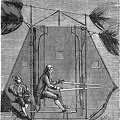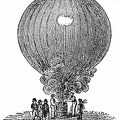The first vacuum balloon was proposed by the Jesuit father, Francis Lana, and described in his book Podromo dell’Arte Maestra Brecia, which appeared in 1670. Though not a practical project like Gusmao’s, it was very ingenious, and marks an interesting phase in the evolution of the fundamental idea of the air ship, or “balloon” as it was called by the inventor, who then coined the word now in common use. Lana proposed to use four copper spheres each 25 feet in diameter and 1/225 inches in wall thickness, quite well exhausted of air, to give ascensional force which he computed at 1,200 pounds aggregate for the four spheres. From these he would suspend the passengers in a boat having a mast and sail to propel the ship in time of favorable wind. Having computed the buoyancy according to well-known physical laws, he could see no possible objection to his project “unless,” he writes, “it be that God would never permit this invention to be practically applied, in order to prevent the consequences that would ensue therefrom in the civil and political government of men.”
- Author
- Aërial Navigation
A Popular Treatise on the Growth of Air Craft and on Aëronautical Meteorology
By Albert Francis Zahm
Published in 1911
Available from gutenberg.org - Posted on
- Saturday 1 January 2022
- Dimensions
- 528*758
- Tags
- Flight
- Albums
- Technology / Transport / Air
- Visits
- 763
- Downloads
- 41
 Download Photo
Download Photo





